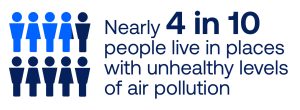The American Lung Association’s recently released “State of the Air” report finds that despite decades of progress cleaning up air pollution, 39% of people living in America – 131.2 million individuals – still live in places with failing grades for unhealthy levels of ozone or particle pollution. This is 11.7 million more people breathing unhealthy air compared to the years covered by the 2023 report (2019-2021), which reinforces the need to protect our local communities from the continued risks to public health resulting from of a combination of factors, including extreme heat, drought, wildfire smoke and more.
For the eighth consecutive year, St. Louis avoided being ranked among the top 25 most ozone-polluted U.S. cities, coming in at number 30 on the list out of 228 metropolitan areas. The region ranked 33rd on the list for most polluted cities by annual particle pollution, which is back six spots from the previous year. The most current report findings have added to the evidence that a changing climate is making the job of cleaning up the air and protecting human health more difficult. High ozone days and spikes in particle pollution related to extreme heat, drought and wildfires are putting millions of people at risk and adding challenges to the work that states and cities are doing across the nation to clean up air pollution.
According to the 2024 report, exposure to unhealthy levels of ozone air pollution continues to make breathing difficult for more people across the country than any other single pollutant. For the three years covered in this year’s report (2020-2022), some 100.6 million people lived in the 125 counties in 26 states that earned an “F” grade for ozone, including St. Charles County in Missouri and Madison County in Illinois. This means that three of every 10 people – including 22.5 million infants and children, 15.5 million people age 65 or older and tens of millions in other groups at risk of health harm – are exposed to high levels of ozone on enough days to earn the air they breathe a failing grade.
While ozone air pollution remains a serious threat to public health, one trend continuing in a positive direction for the fourth consecutive report is the number of people living in counties with a failing grade for ozone that actually declined, this year by 2.4 million people. The long-term trend of improvement can be attributed to controls placed on emissions that have increasingly resulted in the replacement of more polluting engines, fuels and industrial processes nationwide.
For more on ways to do your share for cleaner air this summer and to stay alert about regional ozone pollution levels, sign up to receive the daily air quality forecasts at CleanAir-StLouis.com, like the Clean Air Partnership on Facebook, or follow us on X, formerly known as Twitter, @gatewaycleanair.
To access the full 2024 “State of the Air” report, visit Lung.org.

